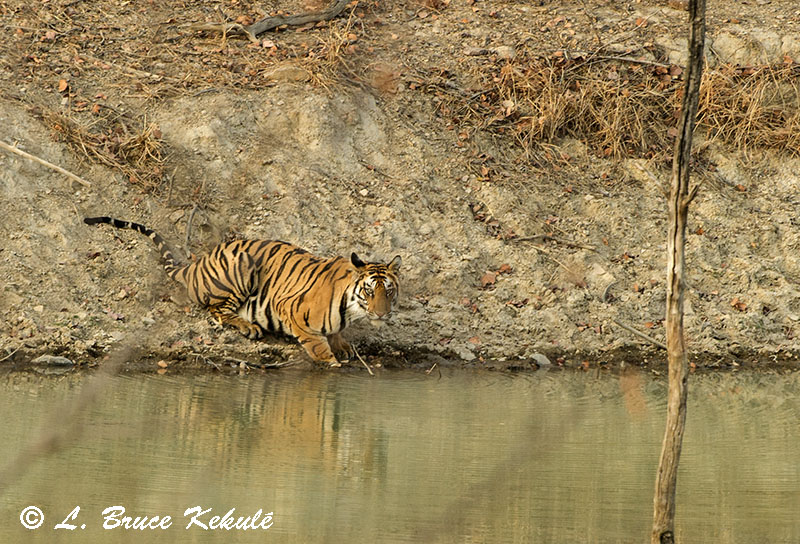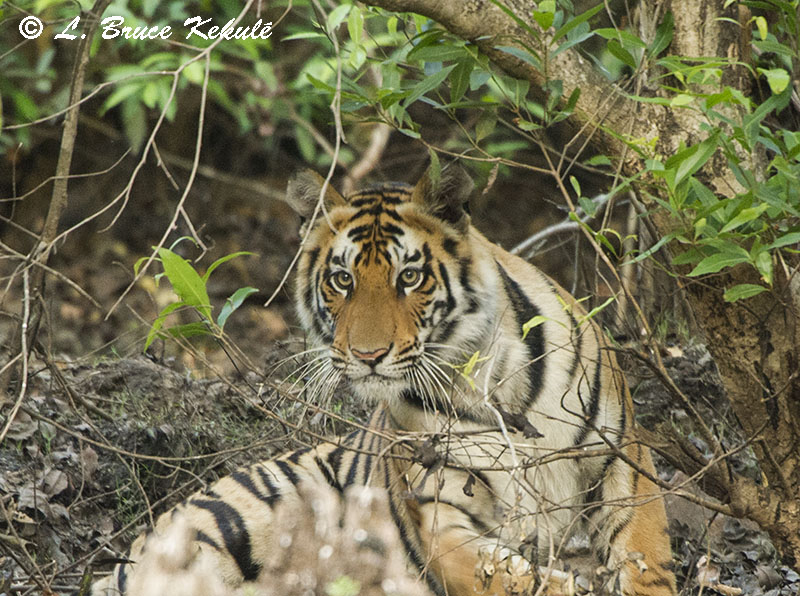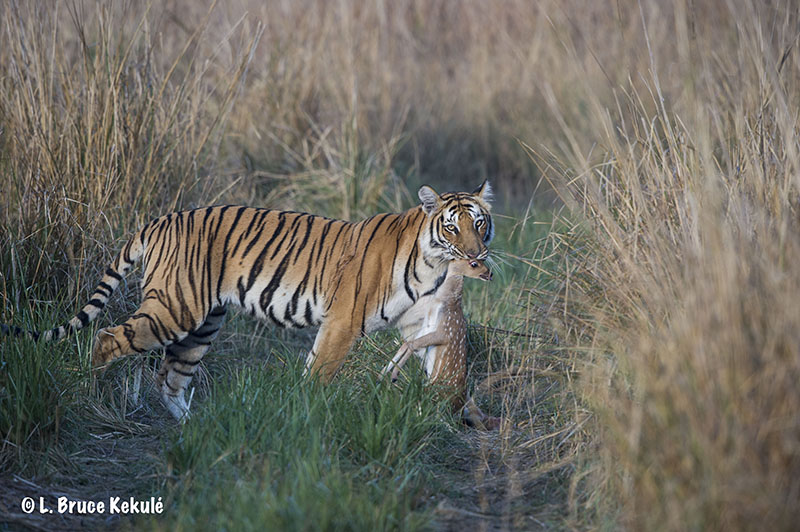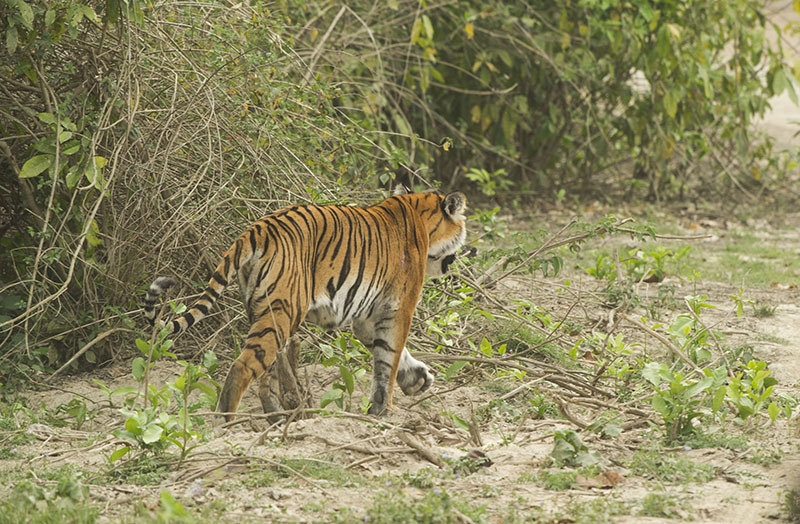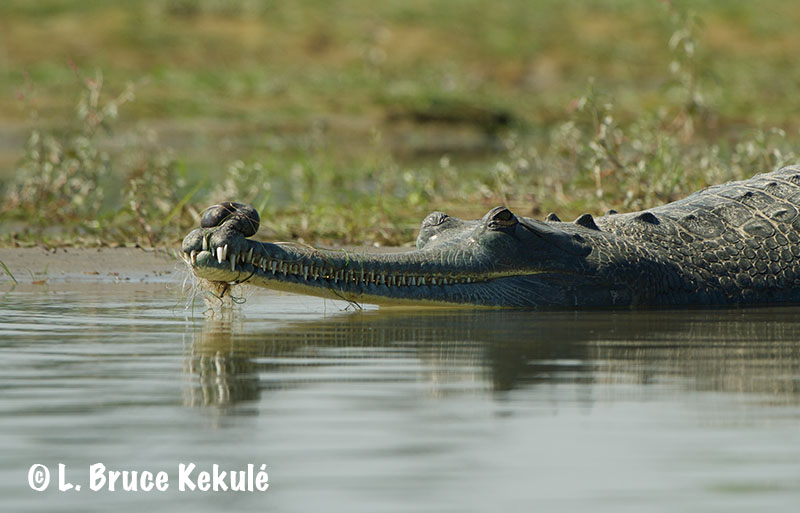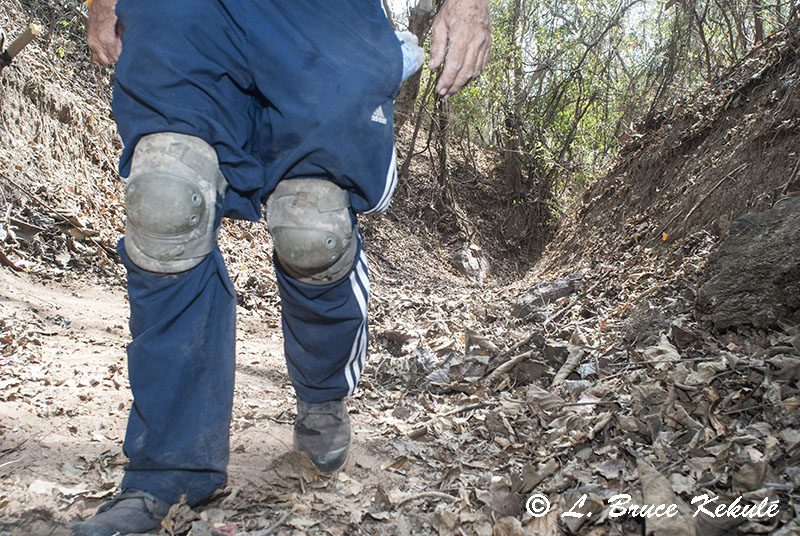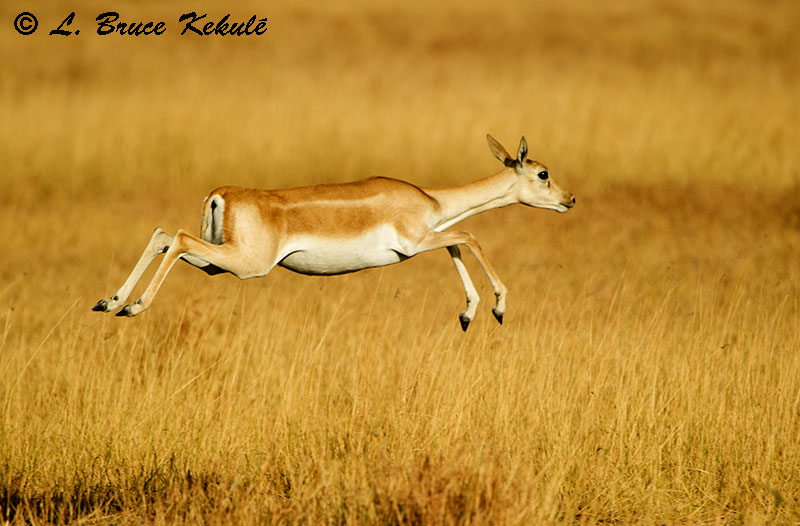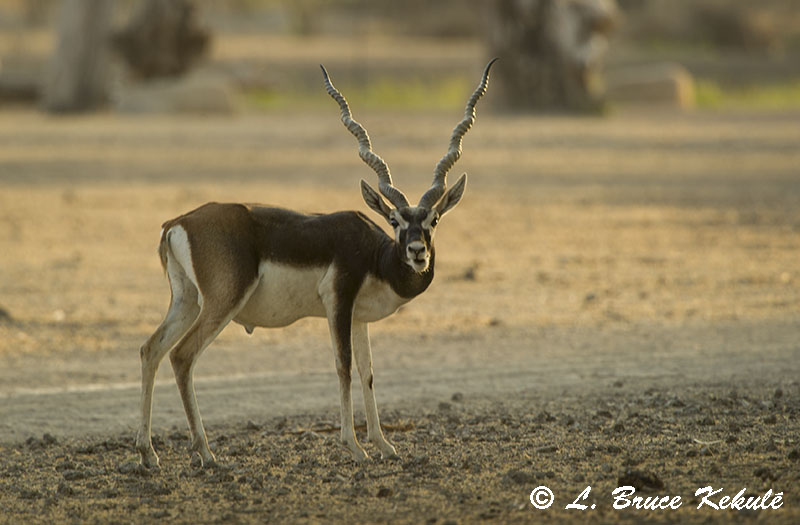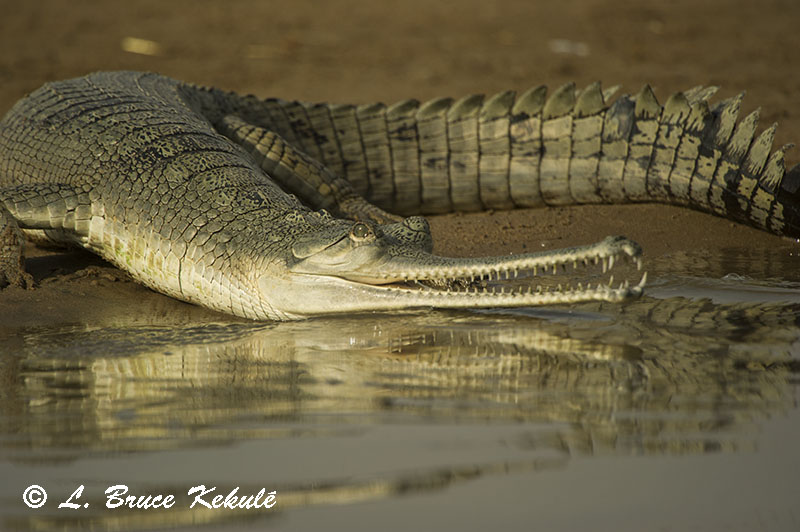Posts Tagged ‘India’
The Taj Mahal – One of 7-Wonders in the World
A Fairy Tale ending in a Bad Dream…!
Side view of the Taj Mahal at sunrise – my favorite shot on this trip…!
Since 2013, I have visited India every year primarily to the ‘tiger reserves’. I now have 50 tigers in my files. In 2018 this year, I arrived in Delhi on Feb. 18th and went straight up to Corbett with my Indian agent and we spent the next 7 days touring around looking for tigers. I ended up getting four tigers on this trip. I also visited a private reserve named Vanghat situated on the Ramnagar River. I managed to set 5 camera traps up on the ridge-line overlooking the resort. I got a tiger crossing in front of a video camera during the morning hours in beautiful light. I also lost one of the traps to a tusker elephant that left it in pieces.
From there I went to the Chambal River and got some good gharial and mugger croc shots. After that, it was to Kanha and Bandavgarh tiger reserves where I got five tigers (two in Kanha and three in Bandhavgarh). All I can say is: Kanha is now very nice to visit with new restrictions set in place by the park’s director and staff, and it was an absolute joy visiting. I got some really nice tiger shots. I recommend anyone wanting to see and photograph tigers: visit Kanha. You will be pleased as it is the best run tiger reserve and national park in the country.
However, Bandhavgarh is a horse of another color. When a tiger is seen, the screaming and shouting that goes on between the drives jockeying for position is the worst I have seen in India. I got three tigers but my agentdriver was one of the main culprits and I had to hold on for dear life. I had one heck of time staying in the jeep as he raced all over the place screaming at everyone to get out of his way. My agent/guide was not there that day to see this fiasco that goes on all the time in Bandhavgarh. The Forest Department here should be ashamed of themselves for letting this develop, and this is played out everyday and needs immediate attention.
Front view of the Taj Mahal in the early morning…!
My agent decided that she would not stay with me and then complained of a sore back, and then abandoned me the next day. The only problem I have with this (I am a big boy and can take care of myself in tiger country) is she went back to Delhi and then straight down to Tadoba Tiger Reserve to go out hunting tigers with a rich Indian client on my money. Both of them managed to get small cubs and a mother, and I think her sore back must have gone away as she posted her trip on Facebook a couple of days later. She charged me an arm and a leg for this trip and I really started to loose my respect for her then.
My final destination this year was the Taj Mahal with my wife Noi, from Thailand. The 17th Century mausoleum attracts about 12,000 visitors a day and is one of the most popular tourist attractions in the world. India’s official recorded history says that the Muslim Mughal ruler Shah Jahan built the Taj Mahal in memory of his third Queen, Mumtaj Mahal in 1643.
We wanted to visit this place together that should be on everyone’s bucket list. It is one of the seven great wonders of the world and seeing this amazing monument is inspirational. I told my agent that my wife broke her leg several years ago and had a walking problem. I asked her if she could get a wheelchair for Noi who is 74 this year. I however overlooked asking her about the wheelchair and a dedicated honest guide to take us into the Taj as we left Delhi. That was the most serious mistake that I have ever made with her so far. She should have provided both of these services for us but she let us down by skimming money off the large extra payment we gave her for this last trip.
Me and Noi at the Royal Gate to the Taj Mahal…!
So when we got to the car park the next morning which is 1 ½ kilometers from the main gate, we were surrounded by a group of local vultures that prey on unsuspecting tourists like me and my wife. We finally agreed on a guide and a wheelchair. He was a smooth-talking self-appointed guide and I had my reservations but we went in anyway not wanting to bother too much about anything. We just wanted to see the Taj and surrounding areas. We went around and the wheelchair did come in real handy for Noi.
I came back the next day and I asked if he could get me through the gate again. We agreed on a price. I had my Nikon D4s and my D700 secondary camera with two different lenses attached and another beautiful U.S. $1,400 Zeiss 28mm lens for Nikon in my vest pocket. As I entered the security gate, the lens was lifted from my view and disappeared (stolen). When I went for it to actually photograph the Taj, it was no where to be found, and that was that. The final straw was my agent refused to call us before we left to say thank you and/or goodbye after we paid her a lot of money. She could not be bothered. And the spirits of the forest know that I speak the truth.
Some of you who are friends my ex-agent may not like what I have to say here and may take offence, but the Facebook ‘defriend’ option is right there and that’s fine with me. I have known her since 2014 when she was partnered with another man from Mumbai running a wildlife photography tour agent company. He was the most famous ‘smoker’ awhile back to ever light-up a cigarette in a national park in India that went completely viral. He also did a number on me when he was with her promising the world and not delivering. She also smokes cigarettes in the tiger reserves, usually at a rest stop where she hides, and has most of the guards in her pocket.
This is what happens when you believe in people that are actually dishonest agents with bad intentions and services, and eventually they take advantage of you. There maybe some good ones out there but it will be extremely difficult for me to believe in any of them. I apologize to all my good friends and they know who they are. I rest my case and this will be the last time I will talk about a crooked guide service. But you have been warned and should share this with as many people as possible so that others don’t get ripped off by these two non-professionals…!!
Kanha National Park: The best run protected area in India
A tiger reserve in Madhya Pradesh
‘Jamun Tola Male’ or T-24 drinking at a small natural waterhole early in the morning…!
If someone ever has an urge to visit one of the best ‘tiger reserves/national parks’ in India, pick Kanha in the southeast of Madhya Pradesh State. The forest department is commended for improving the visitation to the park by both local and international tourists, and my hat is off to them for implementing some great new measures.
‘Naina Female’ or T-76 coming straight at us…!
They have made it a regulation that all forest guides be equipped with a GPS (actually a smart phone with a GPS App.) The authorities can now check the speed limit which is 20 kms per hour and is strictly enforced. If a jeep goes off track or goes too fast, a tough lesson will be learned by both the driver and the guide. It is now very well organized and they pay attention as some have already been red-carded for excessive speed and other infringements. That means anywhere from a seven to fifteen-day suspension, or even longer. The drivers/guides now pretty well toe the line which keeps the dust down, and is much safer and more enjoyable then previously…!
T-24 crossing the road…!
While I was there this past February, sightings were down a bit but the department is creating fire lines by burning fallen leaves on the side of the road that somehow effects tiger sightings. I experienced this same thing in Pench National Park last year where they were doing the same thing burning leaves but now I realized for a good reason. I did not really think about it at the time and did not get any tiger sightings, but did hear several tigers roaring in the dense forest. The big cat just moved away from the road temporally. March is when they expedite this safety program to keep forest fire down to a minimum.
T-76 in the late afternoon just before closing time..!
However, I did get two tigers this time shown here; a female known as T-76 or ‘Naina’ in the afternoon as we were heading back to the gate. We stopped at a T-junction for few minutes and she popped out of the grasslands in front of us for some really great head-on shots. Then the next morning as we were motoring around, we bumped into a bunch of jeeps parked along one side of the road. We slipped into a space and were there for 10 minutes when a male tiger was seen rustling in the bushes directly across from us. He then sauntered down to a natural spring and stayed at the waterhole for more than 10 minutes slurping up a needed drink. I kept on shooting until he moved and in a few minutes, he popped out on the road and as he crossed, I got some good flanking shots of ‘T-24’ known locally as the ’Jamun Tola Male’…I was elated to say the least…!
So, my recommendation is: if you want a great visit with the possibility of seeing a tiger, go to Kanha as it is well worth the trip. Again, well done Forest Department Director Dr Sanjay Kumar Shukla IFS Field Director Kanha Tiger Reserve and staff, and I look forward to future visits to India’s best run tiger reserve and national park. Every park in the country should now take note and follow suit, as most of the other ones continue to have serious problems with jeeps racing for position, and absolute mayhem when tigers are spotted. This will be tough to implement but given time, I’m hoping things will get better in the other tiger reserves scattered throughout India.
Forty Tigers…!
India’s amazing big cats
About 20 years ago when I began wildlife photography, I dreamed of going to India to photograph tigers. The rich biodiversity found on the sub-continent is without equal and boasts the largest population of the big striped cat in the world.
My first tiger in India; one of four cubs around ‘Telia Lake’ in Tadoba-Anhari-2013…!
Tiger cubs sparring in Telia Lake, Tadoba-Anhari..a once in a lifetime shot…!
The first photographic book in my library on wildlife is titled ‘Wild India’ by the renowned British photographer, Gerald Cubitt and published by New Holland in London. He traveled all over India capturing most of the wild animals on film including the majestic tiger. The urge to go after this big cat burned in me for many years.
‘Telia lake’ cub up-close on my third morning in Tadoba…!
In late-2009, I photographed an Indochinese male tiger (though the lens) in Thailand from a blind which is a very difficult feat to accomplish. These carnivores are so smart and extremely wary, and tough to see in the wild let alone photograph. I also camera-trapped many tigers in several protected areas situated around the Kingdom.
Tiger cub near the road in Tadoba…!
Tadoba-Andhari Tiger Reserve – Maharashtra State – Count: 11 tigers…!
Tiger cub hunting chital at Telia Lake…she was hesitant and missed the deer…!
But the desire to visit India burned in me until I finally made my first trip in April-2013 to Tadoba-Andhari Tiger Reserve and National Park. I was with my good buddy Luke Stokes who is an up and coming photographer in his own right, and he lives in Thailand like me. We made the flight from Bangkok to Hyderabad, and then the 9-hour taxi ride to the park. I was finally in the ‘Land of the Tiger’…!
Old ‘Wagdoh’ (Scarface) at Telia Lake…he still is the dominant male in this area…!
At the time, Tadoba was one of the top reserves for tiger sightings in India with four tiger cub sisters growing up around Telia Lake. On our second morning, I managed to get a once in a lifetime shot of two sisters sparring in the water. I was certainly off to a good start.
‘Wagdoh’ on the third morning by the road…!
‘Wagdoh’ at the lake the next day,,,!
The next morning, we bumped into the dominant male and father of the four sisters; old Wagdoh (Scarface) out on the road, and a day later, photographed him at the lake. We also got the other two sisters around the lake during the week. Then, we got a breeding pair over in Tadoba National Park as they went about their natural business.
A breeding pair over in Tadoba National Park…!
On our next to the last day in the park, one of the sisters (the jumping tiger facing me) made an appearance near the road to say goodbye, and I got some wonderful close-up shots of her.
Tiger cub by the side of the road saying goodbye…she is the same tiger facing me in the sparring shot…!
Then in early-2015, I made a second trip to Tadoba and managed to get three tigers including Maya T12, Choti Tara T17 and finally, ‘Gabbar’ or ‘Leopard Face’ T42 that had been injured in a fight with another male tiger.
‘Maya’ or T12, is a mature tigress in Tadoba, 2015…!
‘Choti Tara’ or T17, another mature tigress on the road in Tadoba National Park…!
‘Gabbar’ or ‘Leopard Face’ or T42 with a radio collar cooling off in a pond in Tadoba National Park…he was badly injured fighting with another male…!
Ranthambore Tiger Reserve – Rajasthan State – Count: 6 tigers…!
In November-2014, I visited Ranthambore that is India’s most famous tiger reserve. On the third morning of my 7-day safari, I managed to photograph the very infamous dominant male tiger named ‘Ustad’ or T-24, and then later that day got another male named Zalim or T-25, and one of his cubs (he was looking after two cubs at that time).
The infamous ‘Ustad’….I caught him in Zone 1 on my third day…!
Then the next day, I got Ustad’s son ‘Sultan’ or T-72 two days in a row. Finally, I snapped ‘Krishna’ or T-19, an equally legendary tigress. Shortly after that, ‘Ustad’ was thrown in a zoo (jail) on trumped-up charges of killing a forest guard. It became a world-class scandal. Poor ‘Ustad’ was out and never to be photographed in the wild again..!
‘Zalim’ out hunting…he had left his two cabs in the bush…!
‘Zalim’s’ cub in thick bush. This was the only shot I got of this young tiger…!
‘Sultan’ looking bored in Zone 6…one of my favorite tiger shots….! A huge crowd of hundreds of Indian tourist had should up behind me…!
‘Sultan’, son of ‘Ustad’ the next morning, also in Zone 6…!
‘Sultan’ saying goodbye in Zone 6…!
‘Krishna’, a tigress near the Ranthambore Lake…!
Bandhavgarh Tiger Reserve – Madhya Pradesh State – Count: 7 tigers…!
When I made my first trip to Bandhavgarh in November-2014, I was not lucky and did not see any tigers over a four-day visit except for some pug-marks. But in early-2015, I made a second trip to the park and on the finale day of my 4-day safari, got a sub-adult male in the morning and then in the afternoon, photographed ‘Dotty’, a very famous tigress in Zone 2.
A sub-adult male tiger in Zone 2 in 2015…a lucky encounter after 4 days of no sightings….!
A tigress named ‘Dotty’ in the afternoon on day four…another lucky shot…!
In early March of this year (2017), I made my third visit and caught a sub-adult male in Zone 3 on the very first afternoon. The next morning, I bumped into ‘Spotty’ (sister of ‘Dotty’) and two of her cubs (8-9 months old) in Zone 1. On my next to the last safari, I bumped into ‘Solo’ in Zone 2, a mature female at distance for a nice tiger habitat shot as she sat in the morning sun looking for prey.
A sub-adult male on my first day in late afternoon on March 2017 in Zone 3….!
On my second day, we bumped into ‘Spotty’ (sister of ‘Dotty’) and her two cubs in Zone 2…!
‘Spotty’s’ cub on the road in Zone 2…!
‘Spotty’s’ other cub following her sibling and mother….!
A tigress named ‘Solo’ out in the morning sun waiting on prey….!
Kanha Tiger Reserve – Madhya Pradesh State – Count: 1 tiger…!
In early-2015, I visited Kanha Tiger Reserve. Sightings were down at that time but I finally was able to catch the ‘Budbudi’ female tiger one morning as she walked, roared and scent marked looking for a mate. She came real close to our jeep and crossed in front of us, and then posed on the other side.
‘Budbudi’ female tiger marking territory in Kanha…!
‘Budbudi’ female on the other side of my jeep…!
Pench Tiger Reserve – Madhya Pradesh State – Count: 8 tigers…!
In early-2015, I also traveled to Pench and on the very first morning, got the ‘Patdev’ female tigress and photographed her again in the afternoon. The next morning, I got a sub-adult male. On the third morning, I managed to get some great close-up shots of the very famous ‘Collarwali’, a female tigress with seven litters and 26 cubs to her name.
‘Padtev’ tigress in Zone 1 on the first morning in the bush…!
‘Patdev’ tigress in Zone 1 in the afternoon (second sighting that day)…!
Sub-adult male on my second morning…!
‘Collerwali’ on the road in 2015 early the third morning….!
In early-2016, I made a second trip to Pench and photographed ‘Collarwali’ and her two cubs. Then, I got the famous ’Raiyakassa’ male tiger the next afternoon.
‘Collarwali’ still sporting a collar in the early morning on the first day in 2016…!
‘Collarwali’ yawning out in the morning sun..
‘Collarwali’s’ cub and mother resting in the morning…!
‘Raiyakassa’ male tiger and ‘Collarwali’s’ mate in Pench near the lake on March. 2016
I just finished my third trip to Pench but after four days, I left empty-handed. The Forest Department had just burnt fallen leaves along all roads to create fire-breaks and I believe this pushed all the tigers into the interior. There were no sightings in the park at all since the burning.
Panna Tiger Reserve – Madhya Pradesh State – Count: 2 tigers…!
In early-2016, I also traveled to Panna Tiger Reserve. As most people know, Panna lost all their tigers due to poaching sometime in 2009. The Forest Department decided on a reintroduction program and moved several tigers including a female named T-1 from Bandhavgarh into Panna.
A female cub from the ‘T-1 female’ introduced from Bandhavgarh Tiger Reserve…!
On my very first afternoon, I was lucky and photographed T-1’s female cub at a waterhole. On my third and final day, I got T-1’s other female cub at another waterhole.
Another one of ‘T-1’s’ cubs. This was on my way out of the park…she said goodbye…!
Corbett Tiger Reserve – Utterakhand State – Count: 3 tigers…!
Of course, no trip to India would not be complete without visiting Corbett Tiger Reserve in Northern East India. This park is named after the very famous Jim Corbett (naturalist, photographer, author and hunter of many man-eating tigers and leopards in India).
In early-2015, I managed to catch a young female tigress chasing chital deer in the Dhikala grasslands not far from the camp. Throughout that day, we saw her several times.
A young tigress in the Dhikala grasslands chasing chital deer…2015…!
‘Parrwali’ tigress near the Ramgangar River with a chital fawn in her jaws…2016…!
Parrwali on ‘Sambar Road’ not far from Dhikala camp…!
In early-2016, I photographed Corbett’s most famous female tiger at the moment named ‘Parrwali’ with a chital fawn kill in her jaws across the Ramgangar River. This is my best shot of a tiger in India so far; predation is tough to get and I was lucky. I then caught Parrwali and an un-named sub-adult male tiger on ‘Sambar Road’ the next two days.
A mature male tiger crossing the road not far from Dhikala camp…a habitat shot…2017…!
I have just returned from a trip to Corbett in Dhikala and Birjani areas. On the second morning in Dhikala, a male tiger crossed the main road through the ‘Sal forest’ in mid-morning not far from camp and I was able to get some nice shots in the morning sun. In Birjani, I did see the famous ‘Sarmilly’ female tiger in the afternoon on the second day but she stayed hidden for the most part and I did not get a photo.
Kaziranga National Park – Assam State – Count: 0 tigers…!
In Early-2015, I traveled to Kaziranga, one of India’s greatest wildlife reserves with some 2,400 Asian one-horned rhinos, 1,300 wild water buffalos and 1,000 Asian elephants. There are suppose to be about 200 tigers in the park. However, I did not get a tiger but only a set of pug-marks one morning.
Satpura Tiger Reserve – Madhya Pradesh State – Count: 0 tigers…!
In early-2015, I traveled to Satpura but did not see a tiger. They are very difficult to see here.
Vanghat (Private) Eco-lodge – Utterakhand State – Count: 1 tiger…!
I have always wanted to use camera traps in India but the Forest Department does not allow outsiders to do this in any of the tiger reserves, and for the most part is set aside for their own research teams. After some consultations with the owner of an eco-lodge near Corbett, it was decided to set a DSLR camera trap near the Ramgangar River up a mountain ridge line. I managed to get a great shot of a young female tiger on the second night.
Young tigress camera trapped in the Corbett landscape up a ridge line near the Ramgangar River….2016…!
You can say I’m hooked on photographing tigers in India. I’ve just finished my sixth trip and got 6 tigers this time. I look forward to future visits to add more tiger shots to my files.
Note: This number is the actual tigers photographed with some duplication. Nikon D3s, Nikon D4s, D3oos bodies and Nikon 200-400 and Nikon 70-200 Telephoto lenses were used plus a Nikon D3000 for the camera trap shot…!!
The Asiatic Lions of Gir
India’s remarkable conservation success story…!
Hunting lioness close-up in Gir National Park and Sanctuary (buffer zone)….!
Once upon a time, the Asiatic Lion (Panthera leo persica) ranged from the Mediterranean through to the northeastern parts of the Indian sub-continent. The lion disappeared from all these areas due to reckless hunting and loss of habitat except for Gir forest where the last few individuals remained.
Chital (spotted deer) buck passing close to a hunting lioness….!
In 1913, the Nawab of Junagadh and the government became aware that very few lions were left and outlawed all hunting, and began a conservation program to save the species from the threshold of extinction. Due to excellent management and conservation efforts by the Forest Department and immense support from the people of Saurashtra, this carnivore is surviving very well and some 523 individuals now roam in the Gir Asiatic Lion Conservation Area estimated at 22,000 square kilometers in Gujarat State.
Hunting lioness yawning in a dry stream bed in the buffer zone of Gir National Park …!
I decided that it was time to visit Gir and on my finale safari for this year, I took the flight to Ahmedabad from Delhi and then an 8-hour taxi ride to the Asiatic Lion Lodge near to Sasan-Gir, a town close to the gate of Gir National Park & Sanctuary. Sightings of lions have been down but on my second morning, I got lucky.
Lioness coming through the trees following chital deer….!
I bumped into a hunting lioness in the ‘Buffer Zone’ very close to a village in a dry stream bed about 7.00am. She was sighted by the driver and was about a 100 meters away lying down waiting for some chital (spotted deer) but did not attack as the deer passed very close to her. She then got up, yawned and started moving towards us, and then crossed in front on my jeep at 5-6 meters staring right at me. She was in hunting mode and just kept going after the deer. I did not have much time at all and only got off a few shots shown here.
A male (above) and female lion (below) by Ramesh Sarvani….!
I would like to thank Karan Singh Chauhan, the resort manager and his staff for the great hospitality shown while I stayed at the ‘Asiatic Lion Lodge’ in Sasan-Gir. I would also like to thank Ramesh Sarvani for the use of his lion images for this post. Finally, special thanks goes to Anu Marwah, my agent in India. She has made this all possible and I look forward to future visits to this great country with some of the most amazing wildlife in the world.
The Plight of the Indian Gharial
A rare crocodilian under threat
A male gharial with fishnet wrapped around it’s snout…!
I have just returned from a crocodile sanctuary in Northeast India where the common mugger and the rare gharial are found in fair numbers. The Katarniaghat Wildlife Sanctuary covers an area of 400 square kilometers and was established in 1975. The protected area is in the Upper Gangetic plain situated in Uttar Pradesh State in Northeast India
A close-up of the male gharial with fishnet…!
The Katerniaghat Forest provides strategic connectivity between tiger habitats of Dudhwa and Kishanpur in India and the Bardia National Park in Nepal. Its fragile Terai ecosystem comprises a mosaic of sal and teak forests, lush grasslands, numerous swamps and wetlands. It is home to a number of endangered species including the gharial, tiger, rhino, Gangetic dolphin, swamp deer, hispid hare, Bengal florican, the white-backed and long-billed vultures.
A female gharial with fishnet…red-whistling ducks in the back…!
One of the best places in the world for seeing the gharial in its natural habitat is the Girwa River, where it is found sympatric with the mugger crocodile. The population of gharials in this stretch was one of the three that were still breeding, when the project to conserve this reptile from the verge of extinction was initiated in 1975. However, between the years of 2001 and 2005, almost all the gharial nests were raided by tribals who consider them a delicacy.
Another female gharial with fishnet…!
The sanctuary is under the Indian Forest Department’s responsibility, and breeding of the gharial is being carried out at the station next to the lake. This crocodilian was almost wiped out in India by poachers for the crocodile skin trade but was saved by concerted efforts not to loose this important crocodile species. They are breeding quite well here and have been released into the lake. There are about 200 gharial surviving with programs for future reintroduction.
A young gharial in the breeding center…!
Fishing is strictly prohibited but unfortunately, illegal fishing with nets is being carried out by local and Nepalese fisherman, probably at night when there are no patrolling boats around. I photographed quite a few gharials with fishnets wrapped around their snouts. This is of course is unacceptable and the Forest Department at Katarniaghat needs to abduct any people involved in these activities.
Gharials, mugger and whistling ducks…!
The gharials need to be captured and this nylon net material removed. It is the duty of the FD to see that these creatures live their life in harmony without any harm coming to them.
Happy New Year 2017
Hi all: Wishing everyone a wonderful New Year 2017……!!! I was extremely lucky to photograph a tiger cub (No: 2 born in the wild) from the first female tiger (T-1) reintroduce a couple years ago……it was absolutely some of my best tiger encounters in India during early 2016. I will be returning to India in late Feb-early March for one more trip after some particular shots to close out my next book project…hope that all of you will have a great year..!!
A camera trap set at Ken River Lodge – Panna Tiger Reserve – India
Nikon D3000 travel cam catches a palm civet, jackals, wild boar, langur monkey and a semi-feral cat…!
An Asian palm civet in a dry stream bed at the Ken River Lodge, Panna Tiger Reserve, Madhya Pradesh, India…!
In March 2016, I made a trip to Panna Tiger Reserve in India after tigers. I was lucky catching two sisters, the offspring of T1, Panna’s first tiger reintroduced from near-by Bandhavgarh Tiger Reserve. Poachers completely wiped out the big cat in Panna in one year during 2008 but there are 32 tigers thriving now which is an amazing conservation success story.
Jackal shown here bolting from the flash…! These canidae usually travel in pairs…!
I stayed at the Ken River Lodge outside the reserve several kilometers from the front gate to the park. Pugpundee Safari Company manages this hotel plus others in Bandhavgarh, Pench, Kanha and Satpura tiger reserves in the State of Madhya Pradesh.
A wild boar scavenging in the stream bed…!
The owner wanted to see what was roaming the grounds and invited me to set a camera trap in a dry stream bed not far from my room. After two weeks, I came back through to check the Nikon D3000 with a Nikon 24mm manual lens, one Nikon SB-28 flash and a SSII external sensor.
A gray or ‘Hanuman’ langur leaf monkey during the day….!
The cam caught a palm civet, a pair of jackals, a wild boar and a langur monkey plus a semi-feral cat. Although not as glamorous as a tiger or leopard, these wild creatures are still just as important to the ecosystem excluding the cat. Leopard tracks have been found near the river..!
A semi-feral cat; sometimes this feline was found sleeping up at the resort…!
The ‘tiger hunter’ with knee pads walk-testing the D3000…!
Vultures in India…important birds for the habitat…!
While I was on safari in April 2016, I was lucky to get some nice vulture shots on a carcass at Corbett Tiger Reserve and then at a cliff-face in Panna Tiger Reserve.
Himalayan Griffon , Red headed and Cinereous vultures plus a crow on a carcass in the Dikhala grassland in Corbett Tiger Reserve…!
A Himalayan Griffon vulture flying into a spotted deer carcass…!
Long-billed vultures an a cliff-face in Panna Tiger Reserve…!
A vulture on the wing in mid-morning in Panna Tiger Reserve…!
Land of the Flying Antelope…!
Beautiful herbivores with spiraled horns endemic to the Indian subcontinent…!
Blackbuck National Park – Velavadar
A young male blackbuck in mid-air over the grasslands at the Blackbuck National Park in Velavadar, Gujarat State, western India…!
A dream ever since I saw my first pictures of an Indian blackbuck antelope was to photograph these magnificent creatures one day. It has taken me 20 years since I saw them in a book titled ‘Wild India’ by English photographer Gerald Cubitt published in 1985. This was actually my first book on wildlife photography where I got an inspiration to become a wildlife photographer.
A mature male blackbuck seeking a female in heat early the first morning of my safari…!
I have seen many photographs of blackbuck since then in many other books on India, and on Facebook. I decided that a trip to the blackbuck sanctuary in Gujarat, western India this time around would be part of my month-long safari through March and April, 2016.
A female blackbuck in mid-air on the second morning while on safari in Velavadar…!
I left Delhi by plane and arrived in the city Ahmedabad for an overnight stay at a nice hotel in the city. The next morning after breakfast, my taxi from the night before picked me up and we headed out.
Female blackbuck antelopes in the air after crossing the road in front of our jeep…!
The drive took about 4 hours to the Blackbuck National Park in Velavadar, and I saw the herbivores crossing the road as we entered the national park. I knew then that I was in the right place.
Blackbuck males and females in the grasslands…this herd was several hundred strong…!
The hotel named ‘The Blackbuck Lodge’ is a great place to stay and I must congratulate Mr. Mickey Desai for his 6-star hotel in the middle of nowhere. He has made many trips to Africa and other places around the world, and brought those ideas incorporating them into his place. It was truly a comfortable stay and I rested up for the next morning’s safari into the park at 6am.
A male photographed by the ‘Blackbuck Lodge’ in the late afternoon on my last day…!
As we entered the gate the following morning, we immediately bumped into a large herd of blackbuck and I started shooting. I was looking for a particular shot but it didn’t happen the first day. I wanted these nimble herbivores in mid-air having seen many photographs on Facebook. My guide Mr. Siddharth Jhadav had been there for sometime and he told me the conditions had to be right. We also bumped into several animals like nilgai, striped hyena and Indian fox.
A Nilgai also known as ‘blue bull’ in the Blackbuck National Park…!
The next day, as we were motoring along, a large herd of a several hundred or more blackbuck on our left began to move across the road. Then the females began to jump and the rest of the herd followed. The older darker males however were lazy and only ran across. It was fun trying to catch them in mid-air and my dream to photograph this beautiful and amazing antelope has come true…!
A trip to Chambal River in Agra, India
Gharial crocodiles and the Sarus crane were the main objective…!
This was to be my last safari on this month long trip to India. The site is situated in Agra, east of Delhi where the famous Taj Mahal is located.
A female gharial regulating her body temperature early in the morning by the Chambal River in Agra…!
The Chambal River has some very interesting creatures and the main ones I was after were the gharial (thin-jawed fish eating crocodile) and the Sarus crane (the world’s tallest bird). Time was limited and I was lucky to photographed both species in one day.
Another female gharial and its tell-tale thin jaw for catching fish; they are an amazing crocodilian…!
I stayed at the Chambal Safari Hotel some 70 kilometers past the city of Agra. We left at 5am and arrived at the boat landing where a speed boat was waiting near dawn that was another 22 kilometers from the lodge.
And yet another female gharial before slipping into the Chambal River…! No males were photographed…!
Within no time at all, we bumped into gharial and I got several but they were all female. The males would slip into the river as soon as they spotted us.
A breeding pair of Sarus cranes feeding and dancing on Chambal; these wonderful birds mate for life…!
But I was happy to get some decent photographs and as the sun rose into the sky, it became dreadfully hot and light was very harsh so we returned to the hotel for lunch.
The Sarus crane is the tallest bird in the world and they are thriving very well in India at several locations….!
Other species captured were the mugger crocodile and Indian blue peafowl in full display mode. Many water birds are also found here.
A Indian peafowl male in full display. These birds thrive by the river and are absolutely beautiful…!
Back again at 3:30pm and we motored up the river once again. Shortly thereafter, two Sarus cranes were spotted feeding along a sandy bank. I was delighted and surprised to see how close we got to the tall birds.
A mugger or marsh crocodile basking in the morning sun. This reptile is estimated to be about 3 meters long…!
I will return in mid-March 2017 when the weather is much cooler and the crocs are a lot easier to see when they need to bask for long periods in the sun regulating their body temperature due to the very cold river. All in all, it was a quick but very satisfying trip to the Chambal River. Enjoy…!








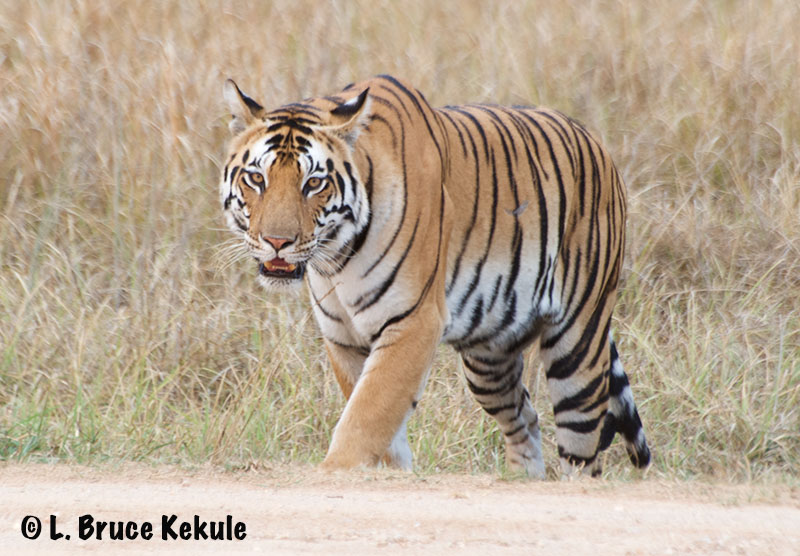
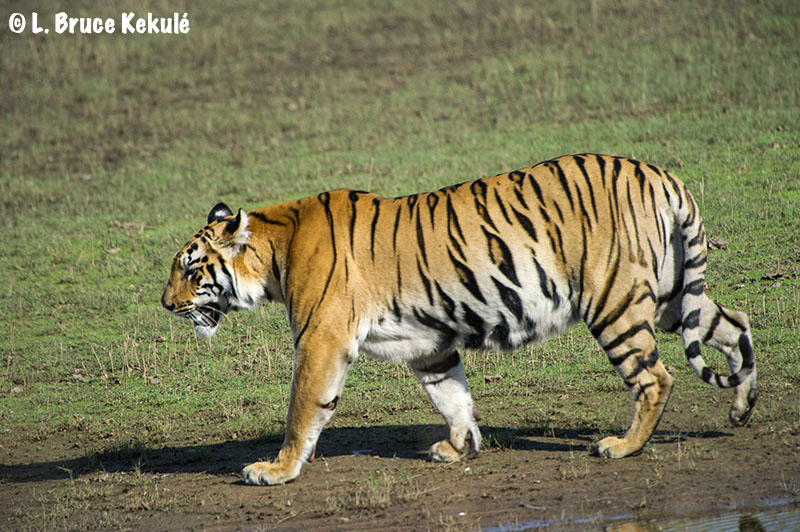




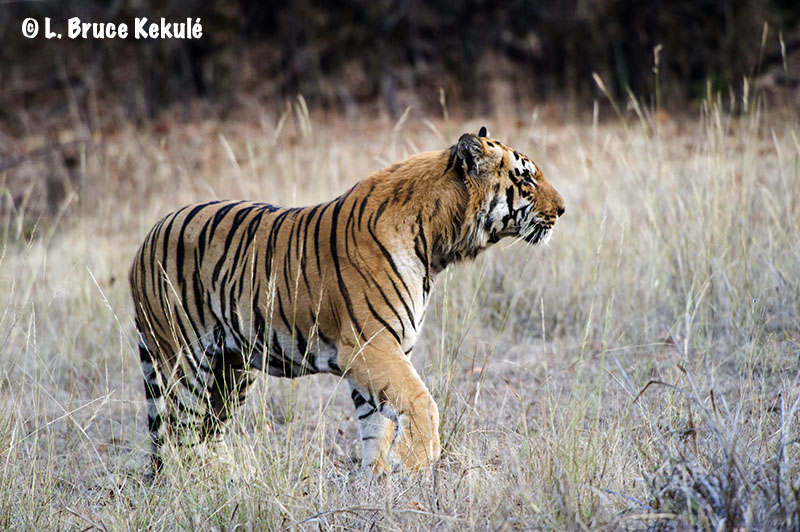




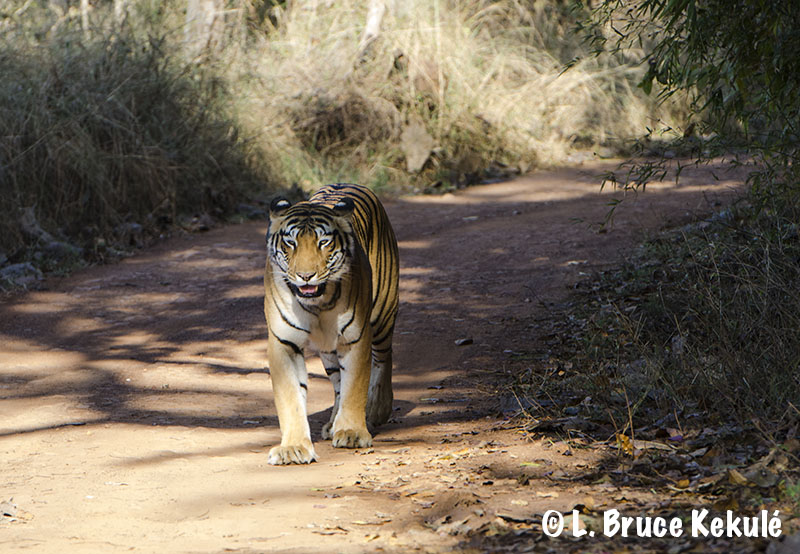


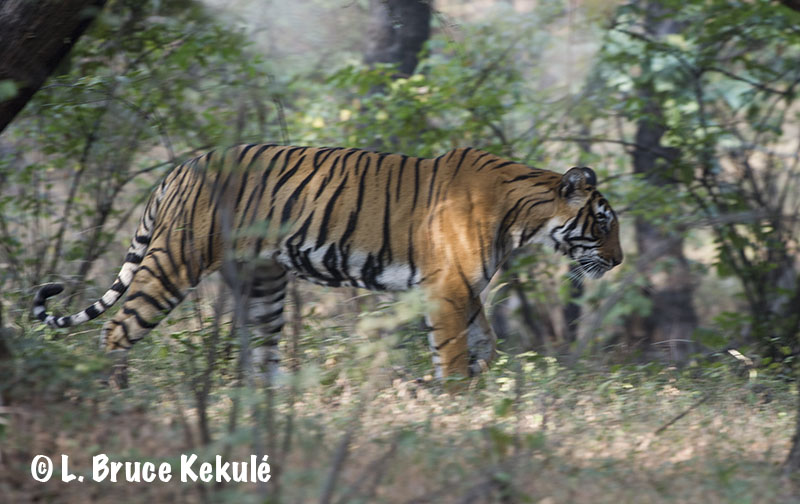

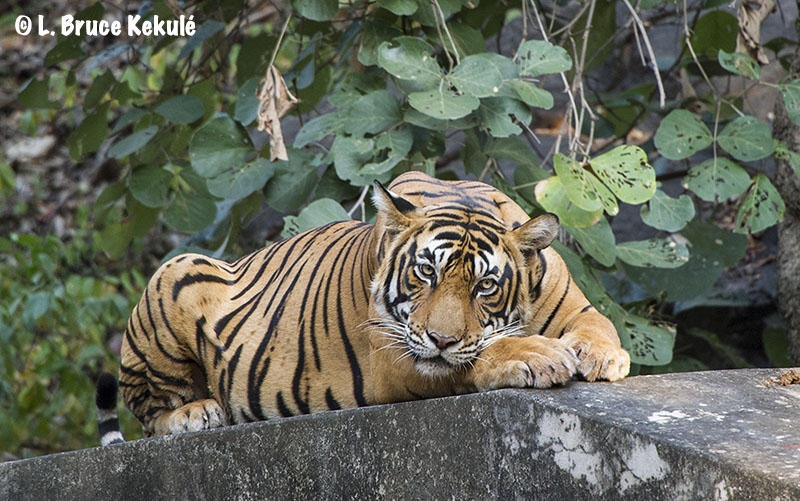

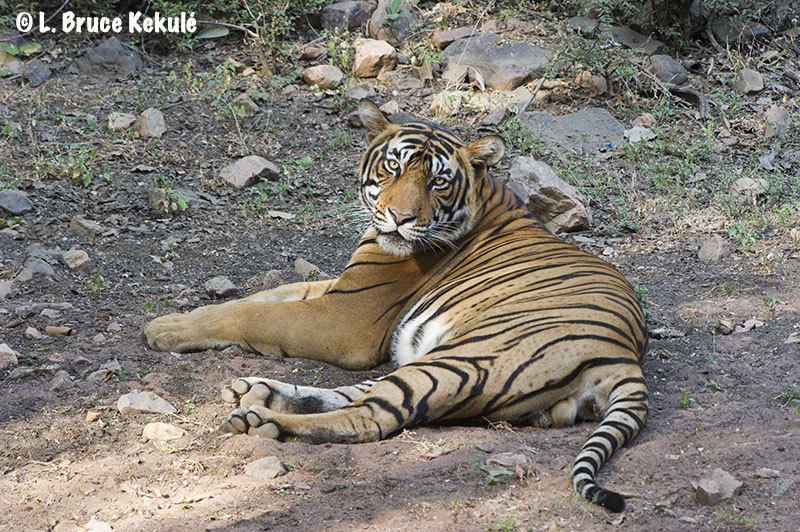






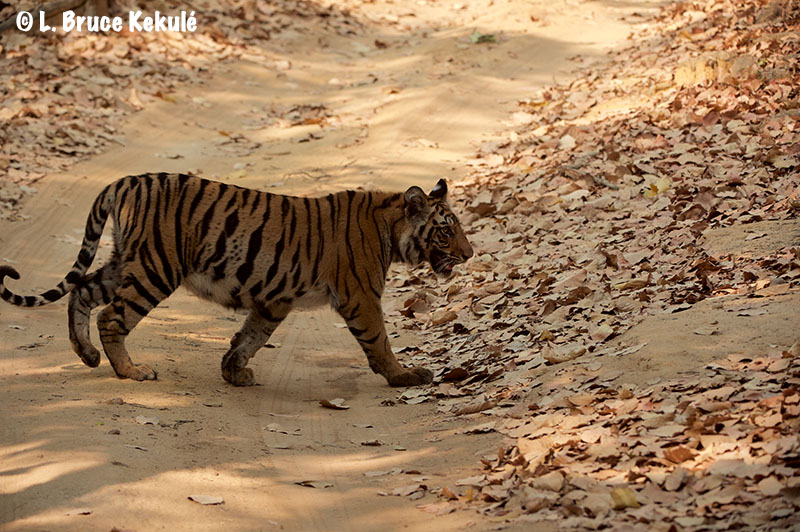


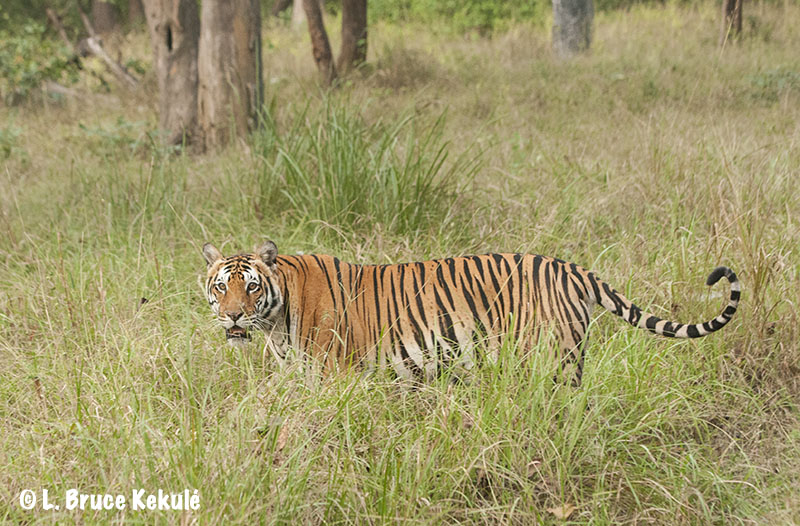
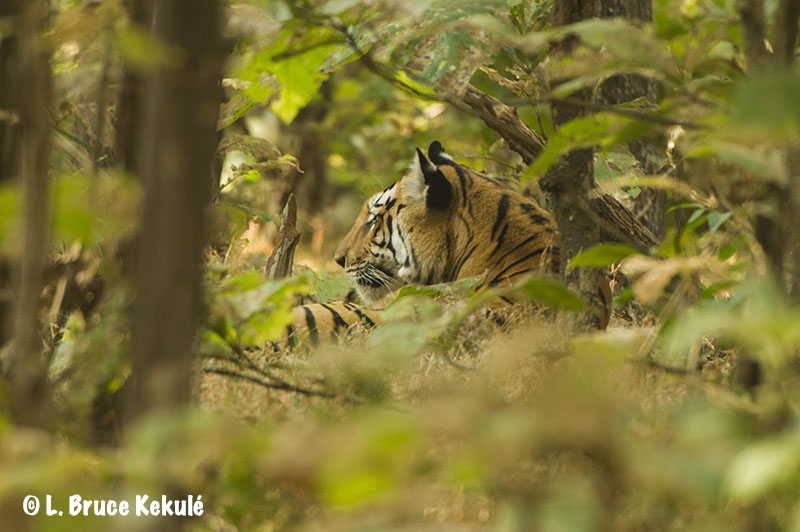

 tev
tev




